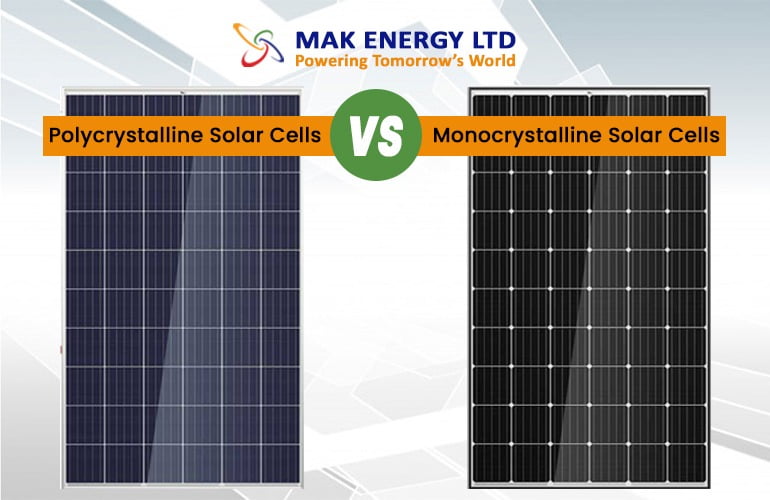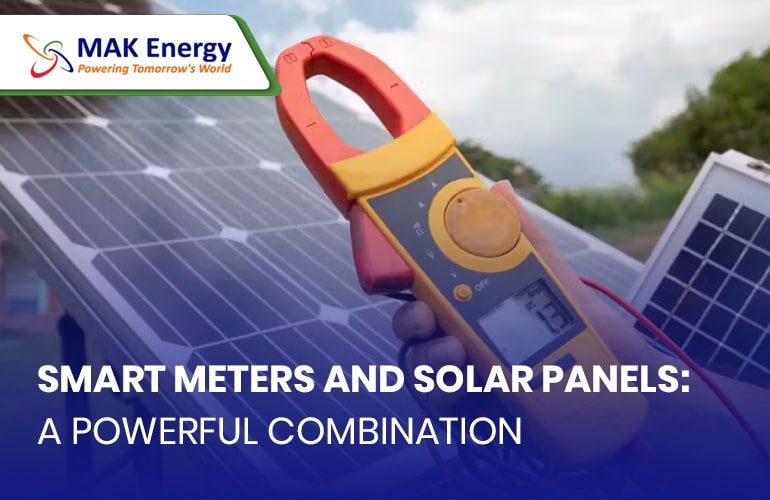Last updated: July 13th, 2023 at 12:02 pm
Are you curious about the difference between monocrystalline and polycrystalline solar panels? As you browse through the world of solar energy, you may have encountered these two distinct types. Let’s dive in and explore their unique characteristics.
When it comes to visual identification, monocrystalline panels sport a sleek dark grey or almost black color, while polycrystalline panels exhibit a charming light blue hue. Although both types are designed to harness sunlight and convert it into electricity, their dissimilarities are crucial to understand.
In this article, we’ll delve into the specifics of these solar panels, unravelling the difference between monocrystalline and polycrystalline. From their performance variations to the ideal choice between the two, we’ll leave no stone unturned. Efficiency and pricing will also be thoroughly examined, empowering you to make an informed decision when it comes to adopting solar energy.

At MAK Energy, we offer a wide range of premium solar panels that deliver the best energy value savings for our clients.
How Do Solar Panels Work?
Before delving into a detailed understanding of the types of solar panels, it might be helpful to grasp the basic workings of solar panels. Solar panels are composed of photovoltaic cells made of silicon. When sunlight strikes the surface of the panels, they generate an electric current, creating an electric field. The resulting current is then directed to a charge controller, which regulates how much current is sent to the battery or inverter for use with different appliances.
Difference Between Monocrystalline and Polycrystalline Solar Panels
What is a Monocrystalline Solar Panel?
Monocrystalline solar panels are made of a single silicon crystal cell that is formed into a crystalline silicon ingot. They are dark in color and are best known for their superior efficiency compared to other types of panels. Monocrystalline solar panels, being composed of a single crystal, provide more room for electrons to move, resulting in higher efficiency and requiring fewer panels to generate the same amount of electricity compared to polycrystalline solar panels.
These panels have a uniform black color and a sleek appearance, making them a popular choice for domestic and commercial installations. Although these panels are considered premium-quality solar panels, they come at a higher price.
What is Polycrystalline Solar Panel?
Like monocrystalline solar panels, this type of solar panel is also made of photovoltaic cells. However, manufacturers of these panels melt multiple fragments of silicon together to form the wafer for the panel. They are also known as multi-crystalline or many-crystalline silicon. Polycrystalline solar panels are blue in color and have lower efficiency compared to monocrystalline solar panels, as there are multiple crystals in each cell, resulting in less space for electrons to move. Nevertheless, they remain a popular choice for many domestic and commercial installations. They are generally less expensive than monocrystalline solar panels, making them a good option for installations with larger roof spaces.
How Do Monocrystalline and Polycrystalline Solar Panels Compare on Key Metrics?
There are significant differences between monocrystalline and polycrystalline solar panels in key areas such as cost, efficiency, lifespan, and more. Let’s explore how these two panels compare to each other in a few areas.
| Key Metrics | Monocrystalline | Polycrystalline |
| Aesthetics | Solar panels are generally dark grey (almost black) | Solar panels are typically light blue |
| Cost | More expensive | Less expensive |
| Efficiency | More efficient | Less efficient compared to monocrystalline panels. |
| Lifespan | More than 25 years | More than 25 years |
| Temperature Coefficient | Best in fluctuating temperature | Less efficient in fluctuating temperatures. |
Aesthetics
Both monocrystalline and polycrystalline solar panels may appear similar, but the primary difference between monocrystalline and monocrystalline solar panels lies in their aesthetic colour. Monocrystalline panels are dark grey, resembling almost black, while polycrystalline solar panels are light blue in colour.
Cost
When comparing the cost difference between monocrystalline and polycrystalline solar panels, it is evident that monocrystalline panels are more expensive due to their higher efficiency. However, this does not mean that polycrystalline solar panels are not a viable option for a solar system. Both types of panels serve the same purpose, with the main difference lying in the silicon structure. While monocrystalline panels come at a higher cost, it’s important to consider that other components required for solar system installation, such as inverters, wires, electrical protections, mounting structures, and labour costs, remain the same regardless of the panel type.
Lifespan
When comparing the lifespan of monocrystalline and polycrystalline solar panels, both types typically come with a 25-year warranty and often last even longer. However, if you have limited space available for solar panel installation, opting for monocrystalline panels may offer a better return on investment.
Efficiency
There is no doubt that monocrystalline solar panels are more efficient than polycrystalline solar panels because they are cut from a single crystal of silicon. Monocrystalline solar panels can achieve efficiencies of over 23%, while polycrystalline panels typically remain below 20%.
Temperature Coefficient
Monocrystalline panels are more temperature resistance, they perform well in the changing temperature while the polycrystalline solar panels are less efficient in the changing temperature.
So Which Solara Panel should I Purchase?
The decision of choosing a solar panel can depend on various factors, including cost, available space for installation, and design. Let’s explore each of these factors individually.
How Much Can You Spend on Solar Panels?
Cost is the primary factor that can influence the decision of purchasing a solar panel. It depends on how much you are willing to spend on the solar panel. If price is not a concern and you prioritize quality, then monocrystalline solar panels are the ideal choice. They offer higher efficiency and attractive design. On the other hand, if you have a limited budget for solar panel purchase, polycrystalline panels are a cost-effective option. Despite being lower in price, they still perform well in warm temperatures and have an efficiency rate of up to 20%.
Space Constraint
If your roof has limited space, the best option is to choose higher efficiency solar panels. Monocrystalline solar panels are the preferred choice for such buildings due to their higher efficiency rate while occupying less space. On the other hand, if you have ample space or plan to install ground-mounted solar panels, the best economical option would be lower efficiency solar panels, specifically polycrystalline solar panels.
Personal Preference
It all depends on your preference. If you are conscious about the color and design of the solar panels and how they will appear on your roof, there is a difference between monocrystalline and polycrystalline solar panels colors. Monocrystalline solar panels typically have a dark grey color, while polycrystalline panels come in a shade of blue.
Where Can I Buy Monocrystalline and Polycrystalline Solar Panels.
MAK Energy offers a range of monocrystalline and polycrystalline solar panels. However, polycrystalline solar panels are now less commonly used, so you will mostly find them available in smaller sizes. For larger applications and better efficiency, it is recommended to purchase monocrystalline solar panels due to their higher efficiency and less space constraints. To get in touch with us, simply drop us a message or fill out our easy quotation form.
Can You Mix Polycrystalline and Monocrystalline Solar Cells?
It is technically possible to mix polycrystalline and monocrystalline solar panels, but it is not recommended due to the difference between monocrystalline and polycrystalline solar panels’ electrical structure. If you are still interested in combining them, it is advised to consult with a professional electrician and installer. Several factors, including voltage, wattage, and amps, need to be carefully considered when mixing monocrystalline and polycrystalline solar panels.
What is the Most Effective Type of Solar Panel?
Due to their higher efficiency rate and greater power per square foot, it can be easily concluded that monocrystalline solar panels are the most effective type. However, polycrystalline panels are also a great option for those seeking to save on upfront solar panel costs. Additionally, if you prefer the blue colour of solar panels, polycrystalline panels can be a suitable choice. Ultimately, both types of panels will help you save on your electricity bill and contribute to environmental protection.
Summary
Solar panels have become the fastest-growing source of electricity production for homeowners and businesses. When it comes to solar panels, people often get curious about the different types available. There are two commonly used types: monocrystalline and polycrystalline solar panels. Both types serve the same function of converting sunlight into electricity. And understanding the difference between monocrystalline and polycrystalline solar panels is crucial when considering a purchase. Monocrystalline solar panels are widely used due to their higher efficiency and greater power generation per square foot.
On the other hand, polycrystalline solar panels are also economical. Though they are less efficient, they still perform well in warm weather conditions. One main difference between monocrystalline and polycrystalline solar panels is their efficiency rate, with monocrystalline panels being more efficient than polycrystalline panels.




